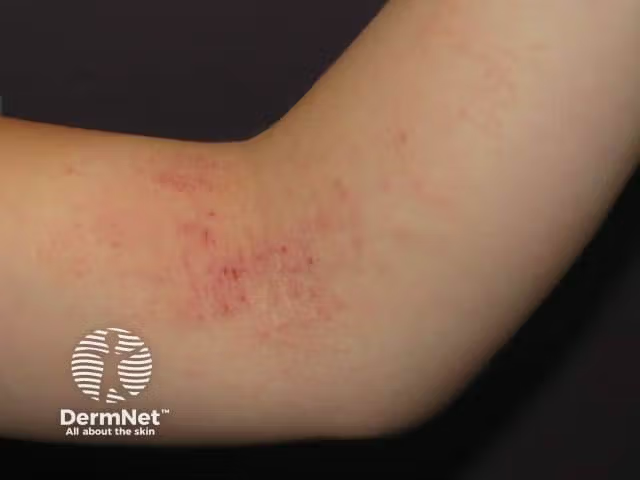- Case-Based Roundtable
- General Dermatology
- Eczema
- Chronic Hand Eczema
- Alopecia
- Aesthetics
- Vitiligo
- COVID-19
- Actinic Keratosis
- Precision Medicine and Biologics
- Rare Disease
- Wound Care
- Rosacea
- Psoriasis
- Psoriatic Arthritis
- Atopic Dermatitis
- Melasma
- NP and PA
- Skin Cancer
- Hidradenitis Suppurativa
- Drug Watch
- Pigmentary Disorders
- Acne
- Pediatric Dermatology
- Practice Management
- Prurigo Nodularis
- Buy-and-Bill
News
Article
Education Drives Success in Atopic Dermatitis Treatment
Author(s):
Key Takeaways
- Biologics like dupilumab are considered the gold standard for severe atopic dermatitis, but systemic therapies must be tailored to individual patient circumstances.
- Patient education is crucial for treatment compliance, with proper skincare routines significantly impacting outcomes.
A recent expert discussion highlighted the importance of long-term planning, including when and how to adjust or transition therapies.

At a recent Dermatology Times Case-Based Roundtable event, experts, residents, and practitioners explored clinical strategies for managing atopic dermatitis (AD). This chronic inflammatory skin condition presents significant challenges for patients and clinicians alike. The session—led by Aaron Farberg, MD, chief medical officer at Bare Dermatology in Dallas, Texas—emphasized real-world therapeutic approaches, patient education, and emerging treatments, offering attendees practical insights and actionable takeaways.
Case 1: Young Woman With Moderate to Severe AD
Farberg began the discussion by presenting the case of a 27-year-old woman with moderate to severe AD involving 20% of her body surface area (BSA). The patient reported significant itching, poor sleep, and an overall decline in quality of life despite using emollients and topical steroids.
One attendee shared his approach: “I use oral steroids short term—maybe 12 to 14 days—to get the patient optimal. While we’re waiting for [dupilumab (Dupixent; Sanofi-Aventis US, LLC and Regeneron Pharmaceuticals, Inc)], I’ll put them on a short course of oral steroids just to kind of calm [things] down and then transition into something like dupilumab.” However, he acknowledged the potential risks associated with steroids and the importance of transitioning to long-term therapies.
The group agreed that biologics like dupilumab are the gold standard for severe AD, but systemic therapies must often be tailored to each patient’s circumstances, including insurance barriers and comorbidities.
The Role of Patient Education
Throughout the discussion, Farberg emphasized the importance of patient education in managing AD. “Education is important if you want the patients to buy into your treatment plan. If they don’t buy in, they’re not going to be compliant,” he remarked.
Panelists shared anecdotes highlighting the transformative power of education. One recounted a case where a young patient’s condition improved dramatically after caregivers finally adopted the recommended moisturizing routine: “Some patients, after a certain amount of time, it just clicks.”
Participants also stressed the importance of addressing misconceptions, particularly among patients with longstanding AD. A participant noted, “I would say choosing the right treatment is important, but really educating patients on proper, excellent skincare makes a big, big difference.”
Advanced Systemic Therapies
The discussion shifted to systemic therapies, with dupilumab emerging as a favored option for moderate to severe AD. Farberg asked the group, “What’s your treatment goal? Should we aim for complete clearance?”
An attendee highlighted the flexibility of Janus kinase (JAK) inhibitors like upadacitinib (Rinvoq; AbbVie): “Why I like using [JAK inhibitors] is because you can start on a lower dose, and you do have the ability to increase.” However, participants noted the importance of discussing potential adverse effects, such as the rare but serious risk of blood clots.
Farberg summarized the consensus: “You’re actually trying to get on the patient’s team. You ask them, ‘What are your expectations? What are your goals? That way you really get in their mindset.”
Emerging Topicals and Combination Approaches
New nonsteroidal topicals, including ruxolitinib cream 1.5% (Opzelura; Incyte) and roflumilast cream 0.3% (Zoryve; Arcutis Biotherapeutics, Inc), generated considerable interest. Farberg presented a case of severe hand dermatitis that was successfully managed with ruxolitinib, prompting discussion on its role in localized AD.
One participant shared, “We had a patient with horrible hand eczema.We started them on [ruxolitinib], and they came into the clinic [a week later] looking so much better. Then they showed me their tube—they had emptied the whole thing basically.” The group acknowledged the importance of educating patients on proper usage to maximize efficacy and minimize waste.
Combining topicals with systemic therapies was another focal point. Participants agreed that adjunctive use of corticosteroids or advanced topicals can help manage flares while initiating biologics. Farberg encouraged attendees to consider practical strategies for integrating newer agents into formularies and patient routines.
Managing Dupilumab Adverse Effects
Farberg asked the group about managing conjunctivitis, a known adverse effect of dupilumab. Several participants recommended prophylactic use of preservative-free artificial tears. One noted, “We kind of as a group just start them on eyedrops even before they start taking [dupilumab] as kind of a [preventive] measure.”The group emphasized collaboration with ophthalmologists to address persistent symptoms and provide specialized care.
Case 2: Adult With Mild to Moderate AD
The second case involved a 36-year-old woman with mild to moderate AD with 8% BSA involvement, primarily affecting her arms and hands. Despite the woman’s use of topical steroids and crisaborole ointment, her symptoms persisted, impacting her sleep and daily life.
Farberg invited participants to share their approaches. One participant suggested exploring environmental triggers: “What are you cleaning the floors with? Does it have a scent, or is it hypoallergenic? What are you cleaning the counters with? Do you have candles in the home? Are they open or are they closed candles? What about fragrance in the air? Those fragrance things that are plug-ins? That can also affect [AD]. It’s maybe not something you’re necessarily thinking about because it’s not on the skin.” Another participant emphasized the importance of patch testing in refractory cases.
Long-Term Treatment Strategies
The discussion concluded with strategies for maintaining long-term disease control. Farberg asked, “Are you keeping patients on biologics indefinitely, or do you consider spacing doses?”
An attendee shared, “It’s like a lifelong medication. Maybe they’ll space it out, maybe try 3 or 4 weeks.” Others noted that some patients could transition to maintenance with topicals after achieving stability on systemic therapies.
Participants also discussed the importance of backup plans, particularly given insurance challenges. One remarked, “In private practice, you always want to have something in mind. What’s the next step? Always have something in the back of your mind. If the patient fails this, what’s going to be your next step?”
Conclusion
The roundtable provided a comprehensive overview of AD management, highlighting the value of patient education, individualized care, and emerging therapies. By prioritizing quality of life and maintaining flexibility in treatment planning, clinicians can optimize outcomes for patients with this complex condition.






